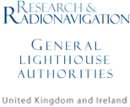Past Performance Counts
Our Customers Are Our Best References
General Lighthouse Authorities of the United Kingdom and Ireland (GLAs)
UrsaNav designed, developed, tested, and delivered a complete set of nine dLoran Reference Station sites and two Monitor and Control System (MCS) sites as part of an Initial Operating Capability (IOC) level Differential Loran (Dloran) System for the General Lighthouse Authorities of the United Kingdom and Ireland (GLAs). UrsaNav personnel installed the initial sites, and assisted GLAs personnel with the remaining installations. Additionally, the Loran transmitting sites at Anthorn, England and Sylt, Germany were upgraded and added to the Operational Data Network.
UrsaNav provided the world’s first combination DGNSS/eLoran “Resilient PNT Receivers” as part of the Accessibility for Shipping, Efficiency Advantages and Sustainability (ACCSEAS) project, a three-year effort supporting improved maritime access to the North Sea Region through minimizing navigation risk. UrsaNav designed, developed, tested, and delivered the Resilient PNT Receivers to the General Lighthouse Authorities of the United Kingdom and Ireland (LGAs). These multi-mode receivers included GPS/DGPS, eLoran, and DGPS Ranging Mode capabilities, and were installed on P&O ferries operating in the North Sea.
Learn More: GLA-RRNAV.org
Chronos Technology, Ltd.

UrsaNav designed, developed, tested, and delivered OEM eLoran PNT modules to Chronos in support of their GAARDIAN (GNSS Availability, Accuracy, and Reliability and Integrity Assessment for Timing and Navigation) and SENTINEL (Sevices Needing Trust in Navigation, Electronics Location, and Timing) projects. These projects investigated interconnected activities involving mission-critical or safety-critical services which need to be able to “trust” GNSS signals at the point of use.
Services Needing Trust in Navigation, Electronics Location, and Timing.
Learn More: Chronos.co.uk
The Republic of Korea
![]()
![]()
UrsaNav has been working with the government of the Republic of Korea on Loran-C and eLoran system design, development, and deployment since the early 1990’s. In that time, two Loran-C stations were constructed and included in the network of Loran-C and Chayka stations known as the Far East Radio Navigation Service (“FERNS”). The ROK, Japan, China, and Russia were FERNS participants.
In 2011, the ROK started looking to upgrade their Loran-C service to eLoran and to increase the number of transmission sites to allow for both an independent, sovereign solution as well as an interoperable, cooperative solution. They want resilient PNT services for their citizens and critical national infrastructure.
As of this writing, only the ROK and the UK have operational eLoran capability. However, we expect that to change as more and more nations confront increased jamming and spoofing of GNSS and other satellite signals.
More Customers
- The U.S. Coast Guard (USCG)
- The Federal Aviation Administration (FAA)
- The U.S. Navy
- The U.S. Naval Observatory
- John Hopkins University Applied Physics Laboratory
- Raytheon GMBH
- The Kingdom of Saudi Arabia
- The governments of China, Denmark, France, Germany, India, Japan, Norway, and Russia.

